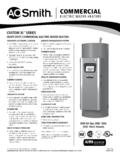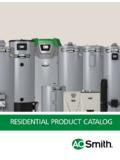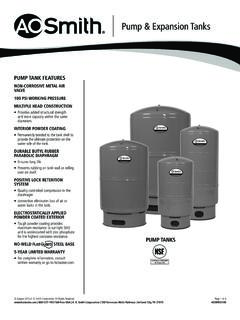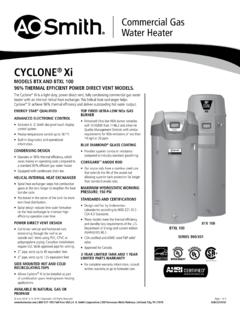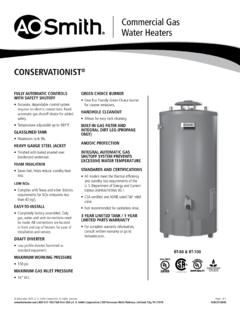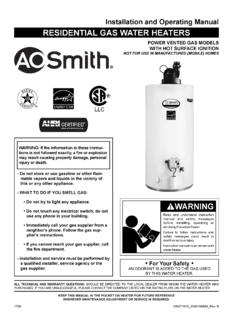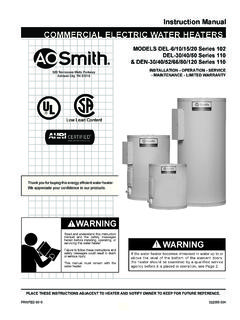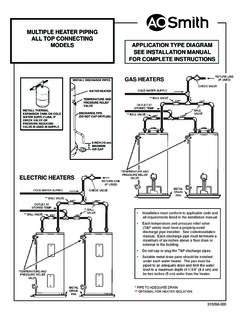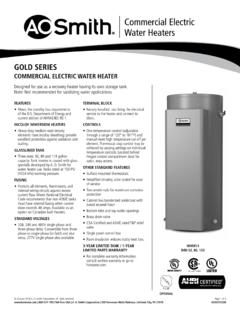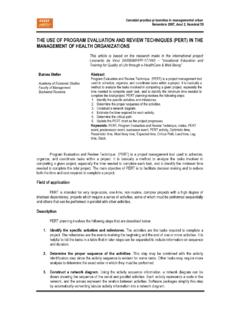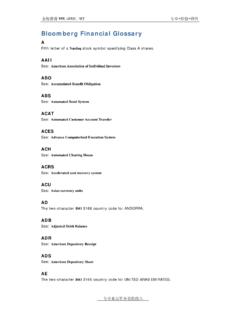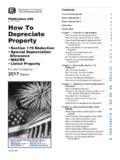Transcription of LAUNDRIES - Water Heaters
1 B January 1983 (Reviewed January 1997)LAUNDRIESREQUIREMENTSThe need for an adequate supply of clean hot Water in the laundryindustry is obvious. The type of load is a steady 8-10 hour perday usage with very high intermittent flow rates. Adequate storageis required in order to supply this intermittent high of their high resistance to corrosion, the A. O. SmithLarge Volume Storage Tanks are ideal for this type of laundry industry may be divided into two major segments,the large commercial or power laundry and the laundry store withindividual machines for each customer. The sizing for these twotypes of usage is somewhat POWER LAUNDRYThe barrel type laundry wheel is programmed for the individualneeds by the operator of the plant.
2 The Water consumptioncharacteristics, even on the same model machine, will vary fromplant to plant with respect to the hot Water consumed and thetemperature at which it is used. For instance, a wheel in a hospitaldoing bed linen could use the first 20 minutes of the cycle as acold Water rinse and the last 20 minutes of the cycle as a 180 Frinse Water , depending upon the type of bleach used. The samemachine, when washing uniforms, could be using an entirelydifferent program. The manufacturer of the machine should beconsulted when possible. The most accurate information forsizing of a laundry of this type is usually obtained from theoperator. However, when the information is not available, anaccepted method of sizing is based on three gallons of Water towash one pound of clothing; half of this Water is hot.
3 Lackingbetter information, consider this hot Water to be 160 STORE (Small Automatic Machines)Laundry stores require adequate hot Water storage plus recoverycapacity equal to the hourly demand of the machines. The lengthof one cycle, plus 10 minutes (for loading and unloading), dividedinto 60 minutes will give you the number of cycles per hour thatmachine is capable of doing. This is usually one and a fraction totwo cycles per hour. The number of cycles per hour multiplied bythe number of machines, multiplied by the gallons of hot waterused per machine will determine the hot Water consumed perhour. This, plus the temperature of the hot Water required willdetermine the recovery capacity of the Water heating information on the time cycle, temperature required, etc.
4 Canbe obtained from the individual manufacturers of the clotheswashing machinery, or your nearest A. O. Smith office. Thesemachines have a set program of operation and are normally notre-programmed by the individual tank selection is based on the number of machines thatcould be drawing hot Water for their wash fill simultaneously. Thetable below gives a diversification factor that is applicable in thistype of TABLES tores with 1-11 machines100% of possible drawStores with 12-24 machines80% of possible drawStores with 25-35 machines60% of possible drawStores with 36-45 machines50% of possible drawThe amount of hot Water used in the wash fill multiplied by thenumber of machines and corrected with a diversification factorfrom the table above, will assist in determining the amount of hotwater that must be available from the storage tank.
5 The A. CER-TEMP 80 Recovery System was developed toprovide maximum draw from storage tanks. Any A. O. Smithcommercial Water Heaters can be installed with forced circulationto a storage tank in this fashion. It is possible to draw 80 percentof the storage tank without encountering an appreciable drop intemperature. Therefore, divide the maximum possible dump drawby to determine the actual gallonage of the storage tank. Thiswill indicate minimum size storage tank of hot Water should be provided in laundryinstallations because of the wash produced depends on anadequate supply of hot Water at the washing machine. In orderto provide this, the best insurance is a recirculating piping layouts for the proper system.
6 Do not use thecirculating pump of the Water heating system for recirculatingwater to the laundry machines. Use a separate AIRIn recent years, the increased use of combination dry cleaningand laundry stores, spot cleaning facilities, liquid bleaches withchlorine base, and pressure cans with Freon propellants hasraised the problem of contaminants in the combustion air suppliedto the equipment. As little as two to three parts per million cancause serious deterioration of the heat exchanger surfacesregardless of the type of heating equipment used. This conditionadversely affects dryers, space heating and Water heatingequipment. Provisions should be made to protect the equipmentby supplying combustion air from an uncontaminated often it is necessary to obtain air from outside the buildingand to maintain a slight positive pressure in the heater room inorder to overcome this problem.
7 It is also possible to developcontaminants in stores that have laundry state building codes have very stringent regulationsregarding ventilation in customer operated dry cleaning should be consulted when dry cleaning is involved in alaundry 2009R (Reviewed January 1997)AOSSG88220211177 1211177 15/6/09 3:42:50 PM5/6/09 3:42:50 PMPrinted in A. O. Smith Corp., Warm Water is necessary in a car-washing operation to materiallyspeed up the washing process and reduce the amount of dryinglabor required. In addition, hot Water is required for automaticmachines used for towel washing. Use of hot Water under highpressure with detergent pick-up by means of venturi action isfast replacing the steam cleaning of automobile wheels and white-wall tires.
8 Scrubbing action of hot soapy Water moleculesproduces a better job faster than the use of steam. Any systemdesigned to mix a detergent with hot Water by venturi action mustbe designed so that detergent is not circulated through the of reclaimed Water has increased in these applications andcirculation of filtered Water through heater(s) from a settling tankis northern climates, where ice accumulates under fenders, thecar washing process is greatly accelerated by using warm temperature of approximately 110 F is ideal for use in a car-washing operation. Water at this temperature will not damagethe wax finish of an automobile. However, Water at up to 180 Fmay be used through a pressure nozzle to clean wheels andwhitewall tires.
9 (Some pressure-nozzle cleaning employs low-temperature warm Water .) Water at 140 F to 150 F is required inwashing machines to wash the towels. In car wash applications,the hot Water storage tank capacity should usually be from 80 to300 gallons. Water should be stored in this tank at the highesttemperature required for the application. Where wheels arewashed with Water power, storage temperature might be from160 F to 180 F and then mixed with cold Water for both the washingmachine and car-rinsing operations. Where wheel washing doesnot require hot Water , the storage tank should be held at 140 Fand mixed with cold Water for the car-washing Water heating equipment should be sized to meet the hourlydemands of the spray nozzle as rated by the manufacturer.
10 Thespray rinse at 110 F will consume approximately 45 GPM withapproximately a half-minute spray period allocated to each wheel-washing operation using Water at 160 F to 180 F willrequire Water at a flow rate of about 5 GPM and will consumeapproximately 2 1/2 gallons per car. Consult the car-washingequipment manufacturer's specifications to determine the specificrequirements for each used with filtered reclaimed Water should be operatedcloser to the 110 F requirement and have controls set toapproximately 115 F or 120 F. This excludes the use of this watersource for wheel washing a service station or any other one-at-a-time hose type carwashing, a small tank electric or gas-fired booster heater will should be stored at 180 F and mixed down toapproximately 100 F through a mixing valve to extend usage timeeach cycle.
